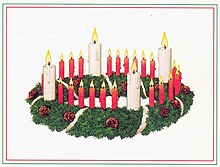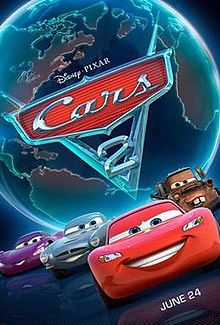Christmas or Christmas Day is a holiday observed generally on December 25 to commemorate the birth of Jesus, the central figure of Christianity. The date is not known to be the actual birthday of Jesus, and may have initially been chosen to correspond with either the day exactly nine months after some early Christians believed Jesus had been conceived, the date of the Roman winter solstice, or one of various ancient winter festivals. Christmas is central to the Christmas and holiday season, and in Christianity marks the beginning of the larger season of Christmastide, which lasts twelve days.
The word Christmas originated as a compound meaning "Christ's Mass". It is derived from the Middle English Christemasse and Old English Cristes mæsse, a phrase first recorded in 1038. "Cristes" is from Greek Christos and "mæsse" is from Latin missa (the holy mass). In Greek, the letter Χ (chi), is the first letter of Christ, and it, or the similar Roman letter X, has been used as an abbreviation for Christ since the mid-16th century. Hence, Xmas is sometimes used as an abbreviation for Christmas.
Advent wreath
History
The ring or wheel of the Advent wreath of evergreens decorated with candles was a symbol in northern Europe long before the arrival of Christianity. The circle symbolized the eternal cycle of the seasons while the evergreens and lighted candles signified the persistence of life in the midst of winter. Some sources suggest the wreath—now reinterpreted as a Christian symbol—was in common use in the Middle Ages, others that it was established in Germany as a Christian custom only in the 16th century.
Other evidence suggests that the Advent wreath was not invented until the 19th century.Research by Prof. Haemig of Luther Seminary, St. Paul, points to Johann Hinrich Wichern (1808–1881), a Protestant pastor in Germany and a pioneer in urban mission work among the poor as the inventor of the modern Advent wreath. During Advent, children at the mission school Rauhes Haus, founded by Wichern in Hamburg, would ask daily if Christmas had arrived. In 1839, he built a large wooden ring (made out of an old cartwheel) with 19 small red and 4 large white candles. A small candle was lit successively every weekday during Advent. On Sundays, a large white candle was lit. The custom gained ground among Protestant churches in Germany and evolved into the smaller wreath with four or five candles known today. Roman Catholics in Germany began to adopt the custom in the 1920s, and in the 1930s it spread to North America. Professor Haemig's research also indicates that the custom did not reach the United States until the 1930s, even among German Lutheran immigrants.
In Medieval times advent was a fast during which people's thoughts were directed to the expected second coming of Christ; but in modern times it has been seen as the lead up to Christmas, and in that context Advent Wreath serves as a reminder of the approach of the feast.
More recently, some Eastern Orthodox families have adopted an Advent wreath with six candles symbolizing the longer Christmas fast in Orthodox tradition, which corresponds to Advent in Western Christianity.

Forms of the Advent wreath
In Catholic churches, the most popular colours for the Advent candles are purple and rose. In the Western church, purple is the historic liturgical color for three of the four Sundays of Advent: once the color associated with royalty, it symbolizes Christ as the "Prince of Peace." Rose is the color for the Third Sunday of Advent, known as Gaudete Sunday from the Latin word "rejoice." Gaudete Sunday anticipates the joy of the Christmas celebration, so its color is a mixture of Advent purple and Christmas white. It may also symbolize the color of early dawn. In Protestant churches, it is more usual to use four red candles (reflecting their traditional use in Christmas decorations) because rose vestments and decorations are not commonly used in Protestant churches. Blue is also a popular alternative color for both Advent vestments and Advent candles, especially in some Anglican and Lutheran churches. This is in keeping with the liturgical seasons; blue means hope and waiting, which aligns with the seasonal meaning of Advent.
Other variations of the Advent wreath add a white candle in the center to symbolize Christmas, sometimes known as the "Christ candle." It can be lit on Christmas Eve or Christmas Day. White is the traditional festal color in the Western church. Four red candles with one white one is probably the most common arrangement in Protestant churches in Britain.

Nativity scene
A nativity scene, crèche, or crib, is a depiction of the birth of Jesus as described in the gospels of Matthew and Luke. While the term "nativity scene" typically includes two dimensional depictions in film, painting, printmaking, and other media, in the history of art and culture, as well as in popular use, the term refers to static, three dimensional, artistic, commercial or folk art dioramas, or pantomimes called "living nativity scenes" in which real humans and animals participate. Nativity scenes exhibit figures representing the infant Jesus, his mother Mary, and Mary's husband, Joseph. A more complete Nativity scene includes other characters from the Biblical story such as shepherds, the Magi, and angels. The figures are displayed in or near the manger or stable.
Saint Francis of Assisi is credited with creating the first nativity scene in 1223 (a "living" one) intending thereby to cultivate the worship of Christ.

Nochebuena
Nochebuena, often translated as "Good Night", is a Spanish word referring to the night of Christmas Eve. In Spain, Cuba, the Philippines and Latin America, the evening consists of a traditional dinner with family.
In the Philippines, this usually comes after the entire family has attended the late evening Christmas Eve mass or Misa de Gallo. Often on the table are: lechón, pancit, fried chicken, hamon, quezo de bola, arroz caldo, lumpia, rice, and adobo among others for the main course. Desserts include ube halaya, bibingka, rice cakes, ice cream, pastries and cakes; drinks include hot chocolate, coffee, soda, wine, beer, and different kinds of fruit juices.

Parol
Parols are ornamental star-like Christmas lanterns from the Philippines. They are traditionally made out of bamboo and paper and come in various sizes, shapes and designs; however, their star-shape façade and basic design remain dominant.
The shape is said to be inspired by the star on the Nativity of Jesus that guided the Magi to the manger. It also symbolizes the victory of light over darkness and the Filipinos' hope and goodwill during the Christmas season.
The word parol came from the Spanish word farol which means "lantern" or ilawan in Tagalog.

Misa de Gallo
Misa de Gallo is the Spanish phrase for Midnight mass, more literally translated as "Rooster's Mass".
It is said that the "Rooster's Mass" owes its name to the idea that a rooster would have been among the first to witness the birth of Jesus, and thus be the one to announce it.
In the Philippines, the prayer is done early morning on Christmas Eve, and it is the last day of a nine-day ritual known as Simbang Gabi. Completing the nine days culminating with the Misa de Gallo is equal to a wish come true, and many Filipinos believe this centuries-old promise to this day.
One of the customs related to the Philippine Misa de Gallo is the selling of traditional Philippine food, such as puto bumbong (a purple colored rice pastry, seasoned with grated--coconut and brown sugar), tsokolate (a hot chocolate drink), bibingka (flour and egg cakes cooked on top and under), and salabat, or ginger tea, which are sold by vendors to the faithful outside churches.
All these topics were done every Christmas season. There are others things that were not placed here in this blog like snowman, the exchange of gifts, singing Christmas carols and many more. Well thats about it. But before I will end this blog post, since is Christmas, you will get a bonus feature. I have found the perfect song for this special day. Check it below. Its the end of my special blog. I hope you liked it. Merry Christmas everybody!!!


